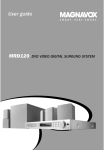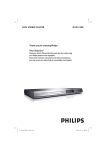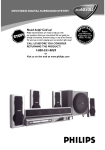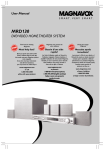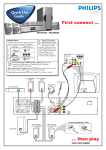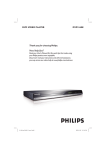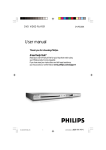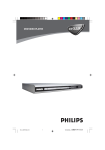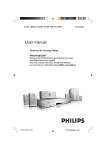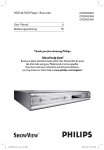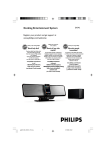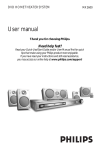Download Philips MX5800SA/21 User's Manual
Transcript
DVD VIDEO / SACD
DIGITAL SURROUND SYSTEM
5800SA
MX
1
México
Es necesario que lea cuidadosamente su instructivo de
manejo.
PRECAUCIÓN - ADVERTENCIA
No abrir, riesgo de choque eléctrico
ATENCIÓN
Verifique que el voltaje de alimentación
sea el requerido para su aparato
Para evitar el riesgo de choque eléctrico, no quite la tapa.
En caso de requerir servicio, dirijase al personal calificado.
Descripción:
Modelo :
Alimentación:
Consumo:
Importador:
Domicilio:
Sistema receptor/reproductor de DVD
MX5800SA/21
110–127 / 220–240V~; 50–60 Hz
150 W
Philips Mexicana, S.A. de C.V.
Av. La Palma No. 6
Col. San Fernando La Herradura
Huixquilucan
Localidad y Tel: Edo. de México C.P. 52784
Tel. 52 69 90 00
Exportador:
Philips Electronics HK, Ltd.
País de Origen: China
Nº de Serie:
______________________________
LEA CUIDADOSAMENTE ESTE INSTRUCTIVO
ANTES DE USAR SU APARATO.
AVISO IMPORTANTE
Philips Mexicana, S.A. de C.V. no se hace
responsable por daños o desperfectos causados por:
– Maltrato, descuido o mal uso, presencia de
insectos o roedores (cucarachas, ratones etc.).
– Cuando el aparato no haya sido operarado
de acuerdo con el instructivo del uso, fuera
de los valores nominales y tolerancias de las
tensiones (voltaje), frecuencia (ciclaje) de
alimentación eléctrica y las características
que deben reunir las instalaciones auxiliares.
– Por fenómenos naturales tales como:
temblores, inundaciones, incendios, descargas
eléctricas, rayos etc. o delitos causados por
terceros (choques asaltos, riñas, etc.).
2
CAUTION
Use of controls or adjustments or
performance of procedures other
than herein may result in hazardous
radiation exposure or other unsafe
operation.
33
This product incorporates copyright
protection technology that is protected by
method claims of certain U.S. patents and
other intellectual property rights owned by
Macrovision Corporation and other rights
owners. Use of this copyright protection
technology must be authorized by
Macrovision Corporation, and is intended
for home and other limited viewing uses
only unless otherwise authorized by
Macrovision Corporation. Reverse
engineering or disassembly is prohibited.
4
Manufactured under license from Dolby
Laboratories. “Dolby”, “Pro-Logic” and the
double-D symbol are trademarks of
Dolby Laboratories. Confidential
Unpublished Works. ©1992-1999 Dolby
Laboratories, Inc. All rights reserved.
Manufactured under license from Digital
Theater Systems, inc. US Pat. No.
5,451,942 and other worldwide patents
issued and pending. “DTS” and “DTS
Digital Surround” are trademarks of
Digital Theater Systems, Inc . 1996 Digital
Theater Systems, Inc . All rights reserved.
Fr a n ç a i s
English ----------------------------------------- 6
English
Index
Español
Français -------------------------------------- 50
Español -------------------------------------- 94
------------------------------------------------------ 138
5
Contents
English
General Information
Disc Operations
Supplied accessories ............................................ 8
Care and safety information .............................. 8
Playable discs ....................................................... 22
Playing discs ......................................................... 22
Turning on /off auto Eco standby mode .. 23
Using the Disc Menu ......................................... 23
Basic playback controls ..................................... 23
Resuming playback from the last
stopped point (DVD/VCD) ........................ 23
Replacing discs without interrupting
playback ........................................................... 23
Selecting various repeat functions .................. 24
Repeat play mode ......................................... 24
Repeating a section within a
chapter/track ................................................. 24
Programme favourite tracks
(audio CDs only) ......................................... 24–25
Clearing the programme ............................. 25
Using the menu bar to programme ............... 26
Playing MP3 disc .................................................. 27
Programme MP3 disc ................................... 27
Connections
Step 1: Set up the surround speakers .............. 9
Step 2: Set up the front speakers
with the subwoofer stands ................................. 9
Step 3: Connecting speakers and
twin subwoofer ................................................... 10
Step 4: Placing the speakers and subwoofer
stands .................................................................... 11
Step 5: Connecting FM/MW antennas .......... 11
Step 6: Connecting TV ....................................... 12
Using Composite Video jack (CVBS) ....... 12
Using Component Video jacks (Pr Pb Y) . 12
Using S-Video jack ........................................ 13
Using an accessory RF modulator ............ 13
Step 7: Connecting the power cord ............... 14
Connections (optional)
Connecting a VCR or Cable / Satellite Box ... 15
Viewing and listening to the playback ...... 15
Using the VCR for recording DVDs ......... 15
Connecting digital audio equipment .............. 15
Listening to the playback ............................ 15
Recording (digital) ........................................ 15
Functional Overview
Main unit and remote control .................. 16–17
Control buttons available on the
remote only ................................................... 17
Getting Started
Step 1: Inserting batteries into the
remote control ................................................... 18
Using the remote control to operate
the system ...................................................... 18
Step 2: Setting the clock ................................... 18
Step 3: Setting the TV ........................................ 19
Changing the NTSC/PAL setting via
the remote control ...................................... 19
Selecting the colour system that
corresponds to your TV .............................. 19
Step 4: Selecting speaker layout ...................... 20
Changing seating control position ............ 20
Setting the speakers’ channels ................... 21
Step 5: Setting language preference ................ 21
6
DVD Menu Options
Using the menu bar ........................................... 28
Using the Karaoke feature ............................... 29
Using the Setup Menu (User Preference
Settings) ................................................................ 30
Setting the TV shape .................................... 30
Improving the image for NTSC setting ... 31
Adjusting the picture position on the TV 31
Selecting a predefined colour setting ....... 31
Fine-tuning the personal colour setting .. 32
Improving the image for Progressive Scan
Video output setting .................................... 32
Setting the digital output ............................ 33
Setting the PCM output .............................. 33
Setting the analogue output ....................... 34
Night mode – turning on /off ..................... 34
Status window – turning on/off ................ 35
PBC (Playback Control) – turning on/ off 35
Help text – turning on/off ......................... 35
Changing the password ............................... 36
Restricting playback by setting
Parental Level ................................................ 37
Locking / Unlocking the DVD for viewing 38
Enabling Play one / Play always .................... 39
Changing the country .................................. 39
Contents
English
Tuner Operations
Tuning to radio stations .................................... 40
Presetting radio stations ................................... 40
Using the Plug and Play ............................... 40
Automatic presetting ............................ 40–41
Manual presetting ......................................... 41
Selecting a preset radio station ....................... 41
Deleting a preset radio station .................. 41
Changing tuning grid .......................................... 41
Timer Operations
Setting the timer ................................................. 42
Activating/ Deactivating the timer ............ 42
Setting the Sleep timer ..................................... 43
Sound and Volume Controls
Sound Control .................................................... 44
Selecting surround sound ........................... 44
Turning on /off clear voice effect ............... 44
Changing subwoofer volume level ............ 44
Adjusting Bass / Treble level ........................ 44
Selecting digital sound effects .................... 44
Volume Control .................................................. 44
Other Functions
Switching on/off ................................................. 45
Switching to active mode ............................ 45
Switching to Eco Power standby mode ... 45
Switching to standby mode (view clock) . 45
Dimming system’s display screen .................... 45
Recording to an external device ..................... 45
Using the remote to operate your television 45
Troubleshooting ............................. 46–47
Specifications ........................................... 48
Glossary ......................................................... 49
7
Gerenal Information
English
Supplied accessories
Care and safety information
Surround / centre
speaker cable
(3x)
Front speaker and
Subwoofer cables
(2x)
Avoid high temperatures, moisture,
water and dust
– Do not expose the system, batteries or
discs to humidity, rain, sand or excessive heat
(caused by heating equipment or direct
sunlight.) Always keep the disc tray closed to
avoid getting dust on the lens.
Avoid condensation problem
Audio cable (red/white)
– The lens may cloud over when the player is
suddenly moved from cold to warm
surroundings, making it impossible to play a
disc. Leave the player in the warm environment
until the moisture evaporates.
Composite video cable
(yellow)
Do not block the vents
Component video
cables (red/blue/green)
– Do not operate the DVD system in an
enclosed cabinet and allow about 10 cm
(4 inches) of free space all around the player
for adequate ventilation.
FM wire antenna
10 cm
(4 inches)
10 cm
(4 inches)
PHILIPS
DVD Home Cinema System
10 cm
(4 inches)
MW loop antenna
Care of disc
DISC/
MEDIA
TV/AV
TUNER
1
2
4
5
7
SURR.
– To clean a CD, wipe it in a
straight line from the centre
towards the edge using a soft,
lint-free cloth. Do not use
cleaning agent, as they may
damage the disc!
– Write only on the printed
side of a CDR(W) and only with a soft felttipped pen.
– Handle the disc by its edge, do not touch
the surface.
AUX/DI
3
6
8
9
0
SOUND
VOL
SYSTEM MENU
Remote control and
two batteries
DISC MENU
SEATING
ZOOM
PREV
NEXT
OK
STOP
DISC SKIP REPEAT
PLAY/PAUSE
REPEAT PROGRAM
A-B
VOICE
MUTE
DIM
SLEEP
SUB
TV VOL
Care of the cabinet
– Use a soft cloth slightly moistened with a
mild detergent solution. Do not use a solution
containing alcohol, spirits, ammonia or
abrasives.
AC power cable
Mini speaker stands
and screws
Brackets and screws
(2x)
(2x)
Additional accessories:
– Adaptor (for version /21S only)
8
(4x)
Finding a suitable location
– Place the player on a flat, hard, stable
surface.
Connections
Step 2: Set up the front
speakers with the
subwoofer stands
screws
English
Step 1: Set up the surround
speakers
front
speaker
mini speaker
stand
1
2
subwoofer
stand
1
1
OR
2
Before connecting the speakers to the DVD
system, firmly attach the mini speaker stands
to the surround speakers using the supplied
screws.
OR
2
Alternatively, you can choose to mount the
speakers on the wall. Attach the supplied
bracket firmly to the rear of speakers using the
supplied screws. Then mount a screw (not
supplied) on the wall where the speaker is to
be hung and hook the speaker securely onto
the mounted screw.
CAUTION!
You should get a qualified person to
attach the brackets to the wall.
DO NOT do it by yourself to avoid
unexpected damage to the
equipment or injury to personnel.
The connections between front speakers and
DVD system are through the twin subwoofer
stands.
1
2
Attach the left front speaker to the left
subwoofer stand and right front speaker to the
right subwoofer stand.
If you want to disconnect speaker from the
subwoofer stand, press the button at the rear
of subwoofer stand while pulling up the
speaker.
Note:
– The front speakers are labelled as FRONT L
(left) or FRONT R (right).
Note:
– The surround speakers are labelled as REAR L
(left) or REAR R (right).
9
Connections
English
Step 3: Connecting speakers
and twin subwoofer
L
R
SUB-WOOFER
SPEAKER SYSTEMS
front speaker
with subwoofer
stand (left)
SURROUND CENTER FRONT
front speaker
with subwoofer
stand (right)
VOLTAGE SELECTOR
L
FM ANTENNA
AUDIO
DIGITAL
OUT
SL
AUX
IN
TV
IN
LINE
OUT
VIDEO
OUT
220V
240V
Pr
Pb
R
DIGITAL
IN
110V
127V
CVBS
L
SR
~ AC MAINS
MW
R
C
Y
P-SCAN
ON OFF
S-VIDEO
Centre
speaker
Surround speaker
(right)
Surround speaker
(left)
Connect the supplied speaker systems using
the supplied speaker cables by matching the
colours of the jacks and speaker cables.
Fully insert the stripped portion of the speaker
wire into the jacks.
Speakers / Subwoofer
Front Left (FL) (L)
Front Right (FR) (R)
black
black
+
white
red
Center (C)
black
green
Surround Left (SL)
black
blue
Surround Right (SR)
black
gray
Subwoofer (L)
black
purple
Subwoofer (R)
black
purple
Notes:
– Ensure that the speaker cables are correctly
connected. Improper connections may damage the
system due to short-circuit.
– Do not connect more than one speaker to any
one pair of +/- speaker jacks.
– Do not connect speakers with an impedance
lower than the speakers supplied. Please refer to
the SPECIFICATIONS section of this manual.
10
Connections
Centre speaker
and DVD system
2
Front speaker
with subwoofer
stand (Left)
Step 5: Connecting FM/ MW
antennas
Front speaker
with subwoofer
stand (Right)
➠
FM
antenna
MW
antenna
1
1
1
2
L
R
SUB-WOOFER
SPEAKER SYSTEMS (4Ω)
SURROUND CENTER FRONT
fix the claw
into the
slot
MW
FM ANTENNA
C
SL
AUDIO
DIGITAL
OUT
AUX
IN
TV
IN
LINE
OUT
VIDEO
OUT
Surround Speaker
(Left)
3
Pb
2
3
Y
S-VIDEO
Surround Speaker
(Right)
For best possible surround sound, all the
speakers should be placed at the same distance
from the listening position.
1
DIGITAL
IN
Pr
CVBS
L
SR
R
3
English
Step 4: Placing the speakers
and subwoofers
Place the left and right front speakers with
subwoofer stands at equal distances from the
TV and at an angle of approximately 45
degrees from the listening position.
Place the centre speaker above the TV or the
DVD system so that the centre channel’s
sound is localised.
1
2
Connect the supplied MW loop antenna to the
MW jack. Place the MW loop antenna on a
shelf or attach it to a stand or wall.
Connect the supplied FM antenna to the FM
jack. Extend the FM antenna and fix its ends to
the wall.
For better FM stereo reception, connect an
external FM antenna (not supplied).
Place the surround speakers at normal
listening ear level facing each other or
mounted on the wall.
Notes:
– To avoid magnetic interference, do not position
the front speakers too close to your TV.
– Allow adequate ventilation around the DVD
system.
MW
FM ANTENNA
Notes:
– Adjust the position of the antennas for optimal
reception.
– Position the antennas as far as possible from
your TV,VCR or other radiation source to prevent
unwanted interference.
11
Connections
English
Step 6: Connecting TV
COMPONENT
VIDEO IN
AUDIO
OUT
S-VIDEO
IN
COMPONENT
VIDEO IN
Pr/Cr
AUDIO
OUT
S-VIDEO
IN
Pr/Cr
Pb/Cb
Pb/Cb
VIDEO IN
Y
COMPONENT
VIDEO IN
AUDIO
OUT
S-VIDEO
IN
VIDEO IN
Y
COMPONENT
VIDEO IN
Pr/Cr
AUDIO
OUT
Pb/Cb
S-VIDEO
IN
VIDEO IN
Pr/Cr
Pb/Cb
VIDEO IN
Y
FM ANTENNA
C
SL
L
MW
AUDIO
DIGITAL
OUT
AUX
IN
TV
IN
LINE
OUT
VIDEO
OUT
SL
Pb
R
Y
DIGITAL
IN
1
2
3
12
FM ANTENNA
AUDIO
DIGITAL
OUT
AUX
IN
TV
IN
LINE
OUT
VIDEO
OUT
CVBS
L
SR
P-SCAN
ON OFF
Y
DIGITAL
IN
3
Pr
Pb
R
S-VIDEO
2
1
MW
C
CVBS
L
SR
R
1
SUB-WOOFER
L
R
SUB-WOOFER
Y
P-SCAN
ON OFF
S-VIDEO
2
3
IMPORTANT!
– You only need to make one video
connection from the following options,
depending on the capabilities of your TV
system.
– Connect the DVD system directly to
the TV.
IMPORTANT!
– Component Video connection
provides higher picture quality. This
option must be available on your TV.
– The progressive scan video quality is
only possible through Component Video
(Pr Pb Y) output.
Using Composite Video jack
(CVBS)
Using Component Video jacks
(Pr Pb Y)
Use the composite video cable (yellow) to
connect the DVD system’s CVBS jack to the
video input jack (or labelled as A/V In, Video In,
Composite or Baseband) on the TV.
To hear the TV channels through this DVD
system, use the audio cables (white /red) to
connect TV IN (L/R) jacks to the
corresponding AUDIO OUT jacks on the TV.
Set the P-SCAN switch to ‘OFF.’
1
2
3
Use the component video cables (red /blue /
green) to connect the DVD system’s Pr Pb Y
jacks to the corresponding Component video
input jacks (or labelled as Pr / Cr Pb /Cb Y or
YUV) on the TV.
To hear the TV channels through this DVD
system, use the audio cables (white / red) to
connect TV IN (L/R) jacks to the
corresponding AUDIO OUT jacks on the TV.
If you are using a Progressive Scan TV (TV
must indicate Progressive Scan or ProScan
capability,) set the P-SCAN switch to ‘ON.’
Otherwise, set it to ‘OFF.’
English
Connections
RF coaxial cable to TV
2
COMPONENT
VIDEO IN
AUDIO
OUT
S-VIDEO
IN
Back of RF Modulator
(example only)
Pr/Cr
Pb/Cb
VIDEO IN
Y
COMPONENT
VIDEO IN
AUDIO
OUT
S-VIDEO
IN
INT IN
Pr/Cr
TO TV
Pb/Cb
VIDEO IN
VIDEO
IN
AUDIO IN
R
L
Y
CH3 CH4
1
SL
FM ANTENNA
AUDIO
DIGITAL
OUT
AUX
IN
TV
IN
LINE
OUT
VIDEO
OUT
CVBS
L
SR
Pr
Pb
R
Y
DIGITAL
IN
3
FM ANTENNA
AUDIO
DIGITAL
OUT
AUX
IN
TV
IN
LINE
OUT
VIDEO
OUT
Pb
R
DIGITAL
IN
Pr
CVBS
L
SR
P-SCAN
ON OFF
Y
P-SCAN
ON OFF
1
3
S-VIDEO
3
IMPORTANT!
IMPORTANT!
– S-Video connection provides better
picture quality. This option must be
available on your TV.
– If your TV only has a single Antenna In
jack (or labelled as 75 ohm or RF In),
you will need an RF modulator in order
to view the DVD playback on the TV.
See your electronics retailer or contact
Philips for details on RF modulator
availability and operations.
Using S-Video jack
2
MW
C
SL
S-VIDEO
2
1
L
R
SUB-WOOFER
SPEAKER SYSTEMS
MW
C
SURROUND CENTER FRONT
L
R
SUB-WOOFER
SURROUND CENTER FRONT
Antenna or Cable
TV signal
Use the S-video cable (not supplied) to connect
the DVD system’s S-VIDEO OUT jack to the
S-Video input jack (or labelled as
Y/C or S-VHS) on the TV.
To hear the TV channels through this DVD
system, use the audio cables (white/red) to
connect TV IN (L/R) jacks to the
corresponding AUDIO OUT jacks on the TV.
Using an accessory RF modulator
1
2
Set the P-SCAN switch to ‘OFF.’
3
Use the composite video cable (yellow) to
connect the DVD system’s CVBS jack to the
video input jack on the RF modulator.
Use the RF coaxial cable (not supplied) to
connect the RF modulator to your TV’s RF
jack.
Set the P-SCAN switch to ‘OFF.’
13
Connections
English
Step 7: Connecting the power
cord
1
2
VOLTAGE SELECTOR
~ AC MAINS
MW
FM ANTENNA
AUDIO
DIGITAL
OUT
AUX
IN
TV
IN
LINE
OUT
VIDEO
OUT
220V
240V
CVBS
L
Pb
R
DIGITAL
IN
110V
127V
Pr
P-SCAN
ON OFF
Y
S-VIDEO
COMPONENT
VIDEO IN
AUDIO
OUT
S-VIDEO
IN
Pr/Cr
~ AC MAINS
Pb/Cb
VIDEO IN
Y
2
After everything is connected
properly,
1
2
Set the VOLTAGE SELECTOR to the local
power line voltage.
Plug in the AC power cord to the power
outlet.
Never make or change any connections with
the power switched on.
On the DVD system,
"AUTO INSTALL – PRESS PLAY" may
appear on the display panel. Press ÉÅ on the
front panel to store all available radio stations
or press Ç to exit (see page 40 “Tuner
Operations”).
PLAY• PAUSE
AUTO INSTALL - PRESS PLAY
DVD VIDEO DIGITAL SURROUND SYSTEM
TREBLE
PLAY• PAUSE
STOP
SEATING
VOLUME
SOURCE
D ISC
RIG
DVD
HT
LE
CENTRE
FT
SEARCH
PROG
TUNING CLOCK•TIMER
SU
RR
ISC CHANGER
SURROUND
RL
SU
SU B
BASS
MIC LEVEL
14
MIC
Connections (optional)
SPEAKER SYSTEMS (4Ω)
S-VIDEO
IN
Pr/Cr
Pb/Cb
VIDEO IN
Y
1
SURROUND CENTER FRONT
COMPONENT
VIDEO IN
AUDIO
OUT
L
R
English
Connecting digital audio
equipment
SUB-WOOFER
Connecting a VCR or
Cable/Satellite Box
MW
C
SL
AUDIO
2
DIGITAL
OUT
AUX
IN
TV
IN
L
SR
R
ANT IN
TO TV
VCR or
Cable/Satellite Box
1
DIGITAL
IN
DIGITAL IN
R
SUB-WOOFER
SPEAKER SYSTEMS (4Ω)
SURROUND CENTER FRONT
DIGITAL OUT
L
MW
FM ANTENNA
C
SL
AUDIO
DIGITAL
OUT
AUX
IN
TV
IN
LINE
OUT
VIDEO
OUT
3
Pr
CVBS
L
SR
Pb
R
Y
DIGITAL
IN
P-SCAN
ON OFF
(for example)
CD Recorder
S-VIDEO
2
4
Viewing and listening to the playback
1
2
Connect the VCR or Cable /Satellite Box to
the TV as shown.
Using the VCR for recording DVDs
Some DVDs are copy-protected. You cannot
record or dub protected discs using a VCR.
4
1
Connect the DVD system’s AUX IN (R/L)
jacks to the AUDIO OUT jacks on the VCR or
cable/satellite box.
Before starting operation, press AUX/DI on
the remote to select “AUX” in order to
activate the input source.
3
Listening to the playback
Connect the DVD system’s CVBS jack to the
VIDEO IN jack on the VCR.
Connect the DVD system’s LINE OUT (R/L)
jacks to the AUDIO IN jacks on the VCR.
This will allow you to make analogue stereo
(two channel, right and left) recordings.
To view DVD playback while recording,
you must connect the DVD system to your TV
using the S-VIDEO (as shown above) or the
Component (Pr Pb Y) video connection.
Connect the DVD system’s DIGITAL IN jack
to the DIGITAL OUT jack on a digital audio
device.
Before starting operation, press AUX/DI on
the remote to select “DI” in order to activate
the input source.
Recording (digital)
2
Connect the DVD system’s DIGITAL OUT
jack to the DIGITAL IN jack on a digital
recording device (DTS-Digital Theatre System
compatible, with a Dolby Digital decoder, for
example).
Before starting operation, set the DIGITAL
OUTPUT according to the audio connection.
(See page 33 “Setting the digital output”).
Notes:
– Some DVDs are copy-protected. You cannot
record the disc through a VCR or digital recording
device.
– Always refer to the owner’s manual of the other
equipment for complete connection and usage
details.
15
Functional Overview
English
Main unit and remote control
1 2
3
4
5
6
789 0 ! @
OPEN•CLOSE
#$ %
^&
DVD VIDEO DIGITAL SURROUND SYSTEM
DISC 1
DISC 2
DISC 3
DISC 4
DISC 5
DISC 1
TREBLE
PLAY• PAUSE
DISC 2
STOP
SEATING
VOLUME
SOURCE
CENTRE
FT
RIG
DVD
DISC 4
HT
LE
DISC 3
D ISC
SEARCH
SURROUND
DISC 5
PROG
TUNING CLOCK•TIMER
SU
RR
5 DISC CHANGER
RL
SU
SU B
BASS
STANDBY-ON
iR SENSOR
MIC LEVEL
1 STANDBY ON
–
–
S SEARCH T (PREV/NEXT)
Switches to Eco Power standby mode or turns
on the system.
*Switches to standby mode.
–
–
2 Disc trays 1~5
3 OPEN•CLOSE 0 (DISC1~5)
–
Opens / Closes the individual disc tray.
4 iR SENSOR
–
Point the remote control towards this sensor.
5 Speaker display panel
–
–
7 TUNING
Switches between frequency tuning and preset
tuning mode.
–
DISC: starts programming.
TUNER: starts *automatic / manual preset
programming.
CLOCK: selects 12- or 24-hour clock display.
–
–
–
–
–
–
DISC: starts/pauses playback.
TUNER: *enters Plug & Play mode and /or
starts preset radio station installation (only on
the main unit).
–
–
Ç STOP
–
–
Exits an operation.
DISC: stops playback or clears a programme.
TUNER: *erases a preset radio station.
Selects multichannel surround, 3D sound or
stereo mode.
@ SOURCE
9 ÉÅ PLAY•PAUSE
–
–
mode)
Turns on / off the seating control diagram on
the TV. Use the VOLUME control on the main
unit or joystick on the remote to select the
desired seating position.
! SURROUND (SURR.)
8 PROG (PROGRAM)
–
–
DISC: *searches backward /forward or selects
a track.
TUNER: *tunes the radio frequency up/ down
or selects a preset radio station.
(On the remote, it can only tune the radio
frequency up / down).
CLOCK: sets the minutes and hours.
0 SEATING (only available in Multi-channel
6 System display panel
–
Selects the relevant active mode : TV/AV, DISC,
TUNER, AUX/DI.
DISC: toggles between DISC 1~5 (only on the
main unit).
TUNER: toggles between FM and MW band.
AUX /DI: toggles between AUX and DI (Digital
Input) mode.
# CLOCK•TIMER
*Enters clock or timer setting mode.
Shows clock display for a few seconds.
$ MIC LEVEL
–
–
Adjusts the mixing level when using the
microphone.
MIC
Plug in the microphone jack.
* = Press and hold the button for more than two seconds.
16
MIC
$ VOLUME (VOL +-)
–
Adjusts the volume level.
^ BASS / TREBLE
–
Selects bass or treble sound. Use the
VOLUME control to select the desired
enhancement level.
@
& n
–
Plugging in the headphones jack. The speakers
output will be cancelled.
!
%
Control buttons available on the
remote only
TUNER
Enters or exits system setup menu.
2
3
4
5
6
7
8
9
0
SOUND
Selects movement direction in the menu.
Use 1 2 to select a preset radio station.
DISC MENU
⁄
SEATING
ZOOM
º
–
¡
™
£
≤
∞
§
Confirms a selection.
¡ DISC SKIP
–
Selects next disc tray for playback.
™ REPEAT
–
NEXT
OK
STOP
) OK
¤
VOL
PREV
–
–
‹
SURR.
)
( Joystick 1 2 3 4
AUX/DI
1
SYSTEM MENU
*
(
0
* SYSTEM MENU (DVD mode only)
–
›
DISC/
MEDIA
TV/AV
DISC SKIP REPEAT
PLAY/PAUSE
REPEAT PROGRAM
A-B
VOICE
MUTE
DIM
SLEEP
SUB
TV VOL
9
8
ª
•
≥
Selects various repeat modes.
£ VOICE (only available in Multi-channel mode)
–
Turns on/off clear voice sound effect.
≤ MUTE
–
Mutes or restores the volume.
∞ DIM
–
Turns on / off the dim mode.
§ SLEEP
–
Sets the sleep timer function.
⁄ DISC MENU
–
–
≥ SUB +–
Adjusts subwoofer’s sound level.
¤ SOUND
• TV VOL +–
Adjusts TV volume (Philips TV only).
Repeats a specific section on a disc.
º ZOOM
–
–
Selects a sound effect.
‹ Numeric Keypad (0-9)
ª REPEAT A-B
–
Enters or exits disc contents menu.
For VCD version 2.0 only;
In stop mode, turns on /off playback control
(PBC) mode.
During playback, returns to main menu.
Enlarges a picture on the TV screen.
–
–
Enters a track /title number of the disc.
Enters a number of a preset radio station.
› B
–
–
Switches to Eco Power standby mode.
*Switches to standby mode.
* = Press and hold the button for more than two seconds.
17
English
Functional Overview
Getting Started
English
Step 1: Inserting batteries into
the remote control
Step 2: Setting the clock
The clock can be set in either 12-hour or
24-hour mode ("12:00 AM" or "00:00" for
example).
3
1
buttons on
front panel
2
DVD system’s
display panel
CLOCK•TIMER
SELECT CLOCK OR TIMER
2
1
2
3
CLOCK•TIMER
Open the battery compartment.
CLOCK
3
Insert two batteries type R06 or AA, following
the indications (+-) inside the
compartment.
4
Close the cover.
5
SEARCH
01:38 PM
PROG
13:38
CLOCK•TIMER
Using the remote control to operate
the system
1
2
3
Aim the remote control
directly at the remote sensor
(iR) on the front panel.
Select the source you wish to
control by pressing one of the
source select buttons on the
remote control (for example
TV/AV, TUNER).
Then select the desired
function (for example ÉÅ,
S, T).
1
OPEN•CLOSE
DISC 1
DISC 2
DISC 1
2
DISC 3
DISC 4
DISC 5
DISC/
MEDIA
TV/AV
3
iR SENSOR
STANDBY-ON
TUNER
AUX/DI
1
2
3
4
5
6
7
SURR.
8
9
0
SOUND
4
VOL
SYSTEM MENU
DISC MENU
ZOOM
PREV
NEXT
OK
STOP
DISC SKIP REPEAT
13:38
Press STANDBY ON to switch on the DVD
system.
DISC 3
DISC 2
SEATING
5
PLAY/PAUSE
REPEAT PROGRAM
CAUTION!
– Remove batteries if they are
exhausted or if the remote is not to be
used for a long time.
– Do not use old and new or different
types of batteries in combination.
– Batteries contain chemical substances,
so they should be disposed of properly.
18
6
6
Press and hold CLOCK • TIMER until
"SELECT CLOCK OR TIMER" appears.
Press T (if necessary) to change the display
to "CLOCK", then press CLOCK • TIMER
again to confirm.
Press S / T to set the minutes and
hours. To increase the speed, hold down
S / T.
➜ The changes in minutes will roll over to the
hours.
Press PROG to change between 12-hour and
24-hour clock mode.
Press CLOCK • TIMER again to store the
setting.
➜ The clock will start working.
To view the clock time in any active
mode
● Press CLOCK • TIMER.
➜ The clock will display for a few seconds.
Notes:
– If the DVD system is disconnected from the
power supply, it will erase the clock setting.
– If you do not press any buttons within 90
seconds, the system will exit clock setting mode.
Step 3: Setting the TV
Selecting the colour system that
corresponds to your TV
IMPORTANT!
This DVD system is compatible with both NTSC
and PAL. In order for a DVD to play on this
DVD system, the colour system of the DVD, the
TV and the DVD system should match.
Make sure you have completed all the
necessary connections. (See pages 12~13
“Connecting TV”).
1
2
Adjust SOURCE control until “DISC X”
appears on the display panel (or press
DISC/MEDIA on the remote).
Changing the NTSC/ PAL setting via
the remote control
TV/AV
DISC/
MEDIA
TUNER
1
2
2
3
5
6
OK
STOP
1en
1en
1
PLAY/PAUSE
st
TV Shape
Black Level shift
Video shift
Color settings
Personal color
Digital Crystal Clear
TV System
1
2
3
Pal
NTSC
Auto
In disc mode, stop playback and press
SYSTEM MENU.
Use the joystick (1 2 3 4) on the remote to
navigate in the menu.
Select
icon and press 4.
and press 2.
Move to
Move to ‘TV System’ and press 2.
Auto – Select this if the connected TV is
compatible with both NTSC and PAL (multisystem). The output format will be in
accordance with the video signal of the disc.
NTSC – Select this if the connected TV is
NTSC system. It will change the video signal of
a PAL disc (VCD only) and output to NTSC
format. Set the ‘Black level shift’ to ‘On’ in
order to improve the colour contrast and
picture when you play an NTSC-compatible
DVD.
Press DISC / MEDIA on the remote to enter
disc mode.
➜ Make sure no MP3 disc is in disc tray 1.
➜ Wait until the system finishes reading the
discs before proceeding to next step.
If playback begins, press Ç to stop playback.
Press and hold DISC/MEDIA on the remote
until “PAL” or “NTSC” appears on the display
panel.
➜ To change the setting, repeat step 2.
NEXT
4
1, 2
4
ZOOM
PREV
AUX/DI
1
DISC MENU
SEATING
➠
Turn on the TV and set to the correct video-in
channel. You should see the blue Philips DVD
background screen on the TV.
➜ Usually this channel is between the lowest
and highest channels and may be called
FRONT, A/V IN, or VIDEO. See your TV manual
for more details.
➜ Or, you may go to channel 1 on your TV,
then press the Channel down button
repeatedly until you see the Video In channel.
➜ Or, the TV remote control may have a
button or switch that chooses different video
modes.
➜ Or, set the TV to channel 3 or 4 if you are
using an RF modulator.
SYSTEM MENU
1
2, 3
PAL – Select this if the connected TV is PAL
system. It will change the video signal of an
NTSC disc and output to PAL format.
4
Select an item and press OK.
To remove the menu
Press SYSTEM MENU.
19
English
Getting Started
Getting Started
English
Step 4: Selecting speaker
layout
SYSTEM MENU
1
2, 3
Changing seating control position
Normally, the best sound spot and the ideal
setting position is in the middle of the room.
With this ‘SEATING’ feature, it allows you to
select the current seating position in the room
and the speaker setting will automatically be
adjusted for optimum performance.
DISC MENU
SEATING
ZOOM
PREV
NEXT
➠
4
OK
STOP
PLAY/PAUSE
1
7
8
9
SURR.
0
SOUND
VOL
1en
1
1en
st
SYSTEM MENU
Digital output
All
Analog output
Multi-channel
Night mode
Off
Karaoke vocal
Off
SEATING
1
2
3
Settings...
PCM output
48 kHz
1
2
Use the joystick (1 2 3 4) on the remote to
navigate in the menu.
icon and press 4.
Move to
and press 2.
Move to ‘Speaker Layout’ and press 2.
3
Personal
4
4
Select the layout that most closely resembles
your speakers’ arrangement, then press OK.
➜ The speaker output will adjust automatically
to suit the selected speaker layout settings
based on the seating position in the middle. To
change the seating position, see “Changing
seating control position”.
➜ If you choose ‘Personal’, the speaker output
will follow the settings in the ‘Speakers‘ menu
(see next page “Setting the speakers’
channels”).
To remove the menu
Press SYSTEM MENU.
20
NEXT
Square
Speakers
In disc mode, press SYSTEM MENU.
Select
ZOOM
2, 4
PREV
Speaker layout
DISC MENU
3
Press SURR. (or SURROUND on the front
panel) repeatedly to select ‘Multi-channel’.
Press SEATING.
➜ The seating control diagram which
represents your current speaker layout
appears on the TV screen. To change the
speaker layout, see “Selecting speaker layout”.
Use the joystick (1 2 3 4) on the remote
(or VOLUME control on the front panel) to
select your current seating position.
➜ During playback, you can hear the changing
of sound effect when you change the seating
position.
➜ If you do not press any buttons within five
seconds, the seating control diagram will exit
from the TV and the system will execute the
last selected seating position.
If you want to turn off the seating feature,
press SEATING again.
➜ “PERSONAL SETTING” appears and
the system will revert to the personal speaker
settings.
Step 5: Setting language
preference
Setting the speakers’ channels
You can adjust the delay times (centre and
surround only) and volume level for individual
speakers. These adjustments let you optimise
the sound according to your surroundings and
setup. Speaker settings are only active on
Multi-channel audio outputs.
1en
1
1en
Digital output
st
All
Analog output
Multi-channel
Night mode
Off
Karaoke vocal
You can select your preferred language settings
so that this DVD system will automatically
switch to the language for you whenever you
load a disc. If the language selected is not
available on the disc, the disc’s default setting
language will be used instead. Except the DVD
system’s menu language, it will remain once
selected.
Off
1en
Speaker layout
Square
Speakers
Settings...
PCM output
48 kHz
1en
1en
1
st
1
ABC
1
2
3
4
Press SURR. (or SURROUND on the front
panel) repeatedly to select ‘Multi-channel’.
6
7
3
In disc mode, press SYSTEM MENU.
Select
English
English
In disc mode, stop playback and press
SYSTEM MENU.
Use the joystick (1 2 3 4) on the remote to
navigate in the menu.
Select
icon and press 4.
– ‘Audio’ (disc’s soundtrack)
– ‘Subtitle’ (disc’s subtitles)
– ‘Menu’ (on screen menu)
icon and press 4.
Press 3 4 to select (Front L&R, Center,
Surround L&R, Sub Woofer), then press 2 to
enter the speaker setting menu.
➜ The test tone will be automatically generated.
st
English
Move to
and press 2.
Move to one of the following and press 2.
Use the joystick (1 2 3 4) on the remote to
navigate in the menu.
and press 2.
Move to
Move to ‘Speakers’ and press 2.
5
2
1
1en
Audio
Subtitle
Menu
4
5
Press 3 4 to select a language and press OK.
Repeat steps 3~5 for other settings.
To remove the menu
Press SYSTEM MENU.
Use 3 4 to adjust the settings for each
speaker that suit your surround sound needs,
which may includes :
A Adjusting the volume levels for one or both
speakers until the sound evens.
B Turning on or off the sound output.
C Delay time settings - use the longer delay
settings when the surround speakers are
closer to the listener than the front speakers.
Press OK to confirm.
To remove the menu
Press SYSTEM MENU.
21
English
Getting Started
Disc Operations
English
IMPORTANT!
IMPORTANT!
– DVD discs and players are designed
with regional restrictions. Before playing
a disc, make sure the disc is for the same
zone as your player.
– Depending on the DVD or VIDEO CD,
some operations may be different or
restricted.
– Do not push on the disc tray or put
any objects other than discs on the disc
tray. Doing so may cause the disc player
to malfunction.
If the inhibit icon (or X) appears on
the TV screen when a button is
pressed, it means the function is not
available on the current disc or at
the current time.
Playing discs
1
2
Playable discs
Your DVD home cinema system will
play:
–
–
–
–
–
–
–
Digital Video Discs (DVDs)
Video CDs (VCDs)
Super Video CDs (SVCDs)
Super Audio CDs (SACDs)
Digital Video Discs + Rewritable(DVD+RW)
Compact Discs (CDs)
MP3 discs
– Maximum 30 characters display.
– Supported sampling frequencies : 32 kHz,
44.1 kHz, 48 kHz
– Supported Bit-rates : 32~256 (kbps),
variable bit rates
SUPER VIDEO
Region Codes
DVDs must be labelled for ALL
regions or for versions / 21RRegion 3, or for versions /21SRegion 4, in order to play on this
DVD system. You cannot play discs
that are labelled for other regions.
ALL
3
4
Note:
– If you are having trouble playing a certain disc,
remove the disc and try a different one.
Improperly formatted discs will not play on this
DVD system.
22
Adjust SOURCE control until “DISC X”
appears on the display panel (or press
DISC / MEDIA on the remote).
Turn on the TV power and set to the correct
Video In channel. (See page 19 “Setting the
TV”).
➜ You should see the blue Philips DVD
background screen on the TV.
3
Press OPEN •CLOSE 0 button once to
open the disc tray and load a disc, then press
the same button again to close the disc tray.
➜ Make sure the disc label is facing up.
For double-sided discs, load the side you want
to play face up.
4
Repeat step 3 for loading a disc onto another
disc tray.
5
Playback will start automatically from the last
loaded disc.
➜ All the available discs will play once, then
stop.
➜ If a disc menu shows on the TV, see next
page on “Using the Disc Menu”.
➜ If the disc is locked by parental control, you
must enter your four-digit password. (See
page 37).
● To obtain the best surround effects, see page
20 “Changing seating control position”.
Note:
– Only one tray can be opened at a time. If you
intend to open the second tray before closing the
first tray, the first tray will automatically close
before the second tray opens.
Disc Operations
buttons on
front panel
1
2
1
2
STANDBY-ON
STOP
DVD system’s
display panel
13:38
AUTO ECO ON
Press and hold STANDBY ON to switch the
system to standby mode.
➜ The clock appears.
Press and hold Ç until “AUTO ECO ON”
appears.
➜ To turn off the setting, repeat step 2 until
“AUTO ECO OFF” appears.
Using the Disc Menu
Depending on the disc, a menu may appear on
the TV screen once you load in the disc.
To select a playback feature or item
● Use the joystick (1 2 3 4) or numeric
keypad (0-9) on the remote, then press ÉÅ
or OK to start playback.
To access or remove the menu
● Press DISC MENU on the remote.
For VCD with Playback Control (PBC)
feature (version 2.0 only)
● In stop mode, press DISC MENU to toggle
between ‘PBC ON’ and ‘PBC OFF’, then the
playback will start automatically.
➜ If you select ‘PBC ON’, the disc menu (if
available) will appear on the TV. Use the
Joystick (1 2 34) to highlight your selection
and press OK to confirm or use the numeric
keypad (0-9) to select a play option.
● During playback, pressing DISC MENU will
return to the menu screen (if PBC is on).
Basic playback controls
English
Turning on/off auto Eco standby mode
This is a power-saving feature, the system will
automatically switch to Eco standby mode if
you do not press any buttons within 30
minutes after a disc has stopped playing.
Pausing playback
● Press ÉÅ.
➜ To resume normal playback, press ÉÅ
again.
Selecting another track /chapter
● Press S / T or use the numeric
keypad (0-9) to key in a track/chapter
number.
Searching backward /forward
● Press and hold S / T, then press ÉÅ to
resume normal playback.
➜ While searching, pressing and holding
S / T again will increase the search
speed.
Selecting next disc
● Press DISC SKIP.
➜ The selected disc will play once, then stop.
Stopping playback
● Press Ç.
Resuming playback from the last
stopped point (DVD / VCD)
● In stop mode and when the disc has not been
ejected, press ÉÅ.
To cancel the resume mode
● In stop mode, press Ç again.
Notes:
– Opening the current disc tray or selecting
another disc tray will cancel the resume feature.
– Resume option may not be available on some
discs.
Replacing discs without interrupting
playback
● Press OPEN•CLOSE 0 buttons of the
inactive disc trays.
For example, if currently disc tray 1 is playing,
you can replace the discs on disc trays 2~5.
23
Disc Operations
English
Selecting various repeat
functions
Programme favourite tracks
(audio CDs only)
You can play the contents of the disc in the
order you want by programming the order of
the tracks to be played. Up to 20 tracks can be
stored.
Repeat play mode
● While playing a disc, press REPEAT to select :
REPEAT CHAPTER (DVD)
– to repeat playback of the current chapter.
REPEAT ALBUM (MP3)
– to repeat playback of the current album.
DISC/
MEDIA
TV/AV
REPEAT TRACK/TITLE
– to repeat playback of the current track/title.
4
REPEAT DISC
– to repeat playback of the current disc or
the programmed tracks (if the programme
mode is active).
TUNER
AUX/DI
1
2
4
5
6
7
8
9
0
SOUND
SURR.
3
VOL
SYSTEM MENU
DISC MENU
SEATING
REPEAT ALL
– to repeat playback of all available discs or
the programmed tracks (if the programme
mode is off).
REPEAT OFF
– to cancel the repeat mode.
Notes:
– Repeat play might not work correctly with some
DVDs.
– For VCD, if the PBC mode is switched on, repeat
play is not possible.
5
4
1
2
3
24
While playing a disc, press REPEAT A-B at
the starting point.
Press REPEAT A-B again at the point to end
the section.
➜ The section A and B can be set only within
the same chapter/track.
➜ The section will now repeat continuously.
Press REPEAT A-B again to resume normal
playback.
NEXT
2, 8
1
2
PLAY/PAUSE
7
DISC SKIP REPEAT
REPEAT PROGRAM
A-B
VOICE
1
4
OK
STOP
3
Repeating a section within a chapter/
track
ZOOM
PREV
3
MUTE
Press DISC SKIP repeatedly to select a disc
tray containing audio CD.
➜ Wait until the system finishes reading the
discs before proceeding to next step.
When the playback begins, press Ç to stop
playback.
Press PROGRAM to enter programme
mode.
➜ "PROGRAM FULL" will appear if you have
programmed 20 tracks.
PROG XX
“XX” = number of programmed tracks
Disc Operations
5
6
7
8
Press S / T or use the numeric
keypad (0-9) to enter the track number.
English
4
Press OK to store the track.
Repeat steps 4~5 to select other tracks.
Press ÉÅ to start programme playback.
➜ Only the tracks programmed from audio
CDs will play.
Press Ç to stop playback or exit programme
mode.
Note:
– If you do not press any buttons within 20
seconds, the system will exit programming mode.
Clearing the programme
● Stop playback, then press Ç again.
➜ PROG disappears from the display panel and
"PROGRAM CLEARED" appears.
25
Disc Operations
English
Using the menu bar to
programme
● To programme only certain Chapter / Index of
the selected Title /Track, go to step 6 (not
applicable for Audio CDs).
Favourite Track Selection (FTS) lets you play
your favourite Titles /Chapters or Tracks /
Indexes in the order you select. An FTS
programme can contain 20 items (Titles,
Chapters, etc.).
6
7
IMPORTANT!
– It is only possible to programme from
the current selected disc tray.
– You have to turn on your TV and set to
the correct Video In channel. (See page 19
“Setting the TV”).
1
2
3
8
9
Insert a disc (DVD,Video CD or Audio CD).
In disc mode, press SYSTEM MENU.
➜ The menu bar will appear across the top of
the TV screen.
Use the joystick (1 2) to select
4 to enter the programme menu.
➜ FTS menu appears.
and press
FTS
Title
Chapter
Program
4
5
Press 4 repeatedly to select ‘Title /Track’ in
the menu.
To programme the entire Title /Track, press
OK.
OR
Press 1 2 to select the required Title /Track
number, then press OK to store.
➜ The number will appear on the ‘Program’
line.
26
Repeat steps 4~6 to select others Title/
Track or Chapter/Index.
Press 3 to select ‘FTS’, then press 1 2 to
select programme ‘On’ or ‘Off’ and press OK
to confirm.
Press ÉÅ to start playback.
➜ If ‘FTS’ set to ‘On’, the programme will play.
➜ If ‘FTS’ set to ‘Off’, tracks will play in normal
order.
● In stop mode, you can press PROG on the
front panel to toggle between programme on
and off.
To erase an FTS programme
1
2
(example for DVD FTS menu)
Move to ‘Chapter / Index’ in the menu, then
press 1 2 to select the required Chapter/
Index number and press OK to confirm.
➜ The Title /Chapter or Track/Index number
will appear on the ‘Program’ line.
Move to ‘Program’ in the menu.
Press 1 2 to select the required number, then
press OK to erase.
To erase the entire FTS programme
● Move to ‘Clear all’ in the menu, then press OK
to erase.
Playing MP3
IMPORTANT!
You have to turn on your TV and set to
the correct Video In channel. (See page 19
“Setting the TV”).
1 Load an MP3 disc.
➜ The disc reading time may exceed 30
seconds due to the complexity of the
directory/file configuration.
2 Playback will start automatically.
➜ A list of albums/tracks menu will appear on
the TV.
(example for MP3 album menu)
Album name 1
Album name 2
Album name 3
Album name 4
Album name 5
Press OK, Right or Play to start playback
(example for MP3 track menu)
Album name 3
Title name 1
Title name 2
Title name 3
Title name 4
Title name 5
Time: 0:00:31
Notes:
– Due to the recording nature of Digital Audio
MP3 (DAM), only digital audio music will play.
– It is normal to experience an occasional “skip”
while listening to your MP3 discs.
– For multi-session discs with different formats,
only the first session will be available.
– Some MP3 discs may be distorted during
playback due to the configuration and
characteristics of the disc.
Programme MP3 disc
It is only possible to programme from the last
selected album. Up to 99 tracks can be stored
in the programme.
1 Stop playback, press Ç.
2 Use the joystick (1 2) on the remote to toggle
between MP3 album and track menu, then
press (34) to make your selection.
➜ Only the tracks from the last selected
album can be programmed.
3 Press PROG to add the desired tracks into
the programming list.
➜ “*” will appear in front of the selected
tracks.
➜ To cancel the current selection, press
PROG again.
Press OK, Right or Play to start playback
● During playback, you can use the joystick
(3 4) on the remote to select another track
in the current album.
● To select another album from the current MP3
disc, press 1 to return to the album menu,
then use the joystick (3 4) to make your
selection and press OK to confirm.
● Press ÉÅ to pause/resume playback.
3 To stop playback, press Ç.
4 Press OK to confirm and begin the programme
playback.
➜ A list of programme tracks appear on the
menu.
Clearing the programme
● Stop playback, then press Çagain.
Note:
– If the DVD system is disconnected from the
power supply or the programmed disc tray is
opened, it will erase the programme.
27
English
Disc Operations
DVD Menu Options
English
Using the menu bar
You can continue a number of operations
directly via the multiple menu bars on the TV
screen without interrupting the disc playback.
The exception is when you enter
(SETUP
MENU), the playback will pause.
SYSTEM MENU
DISC MENU
1
2
SEATING
ZOOM
PREV
Audio Language
DVD: Press 34 to select an audio soundtrack
language available on the DVD.
VCD: Select audio channels :
LEFT VOCAL (LL),
RIGHT VOCAL (RL), STEREO (LR).
Smart Color
Press 34 to select one of the predefined
sets of colour settings : 1 (Personal), 2 (Rich),
3 (Natural), 4 (Soft) and 5 (Animation).
NEXT
3
OK
STOP
1
Subtitle Language
Press 34 to select a subtitle language
available on the DVD.
PLAY/PAUSE
In disc mode, press SYSTEM MENU.
➜ The menu bar will appear across the top of
the TV screen.
Sound mode
Press 34 to select a desired surround sound
output : 6ch (Multi-channel), 3d (3D Sound),
St (Stereo).
Frame by Frame
The playback will pause. Press 1 2 to select
the previous or next picture frame. To
resume normal playback, press ÉÅ.
Slow Motion
The slow motion speed will display.
Press 1 2 to select a reverse or forward
slow motion speed. To resume normal
playback, press ÉÅ.
D
2
3
Use the joystick (1 2 3 4) on the remote to
navigate in the menu.
➜ Press 1 2 to move through the menu bar.
➜ Press 4 to enter the selection. If there are
multiple choices available, press 4 repeatedly
to select.
Press OK to confirm the selection.
➜ Playback will resume or begin automatically.
To remove the menu
Press SYSTEM MENU.
IMPORTANT!
– Some operations may be different or
restricted, depending on the disc format.
Refer to the jacket or case of the disc
you are playing.
– Changing the Subtitle Language and
Audio Language from the menu bar will
only apply to the current disc, it will not
change the default preset.
28
Scan Speeds
The fast scan speed will display. Press 1 2 to
select a reverse or forward fast scan speed.
The volume will be muted. To resume
normal playback, press ÉÅ.
Camera Angle
Press 34 to select to view the same scene
from different angles if the DVD is recorded
with multiple angles.
Enlarge Picture
Press 34 to select an enlarge picture ratio :
1.33, 2 or 4, then press OK to confirm.
You can use the joystick (1 2 3 4) to move
within the enlarged picture on the TV.
To resume normal playback, select the zoom
factor 'Off' from the menu.
Disc
Press 34 to select a disc tray and the
playback will start automatically.
Title
Press 34 to select a Title number
(if available) for playback to begin.
Chapter
Press 34 to select a Chapter number
(if available) for playback to begin.
DVD Menu Options
English
Using the Karaoke feature
Time Search
The playback will pause and a time edit box appears
on the display. Use the numeric keypad (0-9) to
enter the time (hours : minutes : seconds) at which
you want playback to begin, then press OK to start
playback. (this function is not available if the PBC
is set to On)
3
Favorite Track Selection
Stop playback, then select this to enter the
programme menu (see page 26 "Using the
menu bar to programme".
OPEN•CLOSE
DVD VIDEO DIGITAL SURROUND SYSTEM
DISC 1
DISC 2
DISC 3
DISC 4
DISC 5
TREBLE
DISC 1
PLAY• PAUSE
DISC
22
DISC
DISC
3ON/OFF
POWER
STOP
SEATING
VOLUME
SOURCE
CENTRE
FT
DISC
DVD
RIG
HT
3
LE
DISC
DISC
DISC
43 3
DISC DISC
1DISC
DISC
54 4
SEARCH
SURROUND
DISC 5
PROG
5 DISC CHANGER
SU
RR
RL
TUNING CLOCK•TIMER
SU
SUB
BASS
STANDBY-ON
iR SENSOR
MIC LEVEL
MIC
1, 4
1
2
3
4
2
Set the MIC LEVEL control at the front
panel to the minimum level (turn to left) to
prevent acoustic feedback when connecting
the microphone.
Plug in the microphone to the MIC input.
Load a karaoke disc.
➜ Plugging in or out the microphone will
automatically turn on or off the karaoke mode
respectively.
Adjust the MIC LEVEL control to select the
microphone volume level.
● Some VCDs or SVCDs are recorded on
multiple audio channels. For example, a
Karaoke disc may record music on the left
channel and vocals on the right channel.
To choose an audio channel, use the joystick
and press 4 repeatedly to
(1 2) to select
make your selection.
29
001-049-MX58-21-EngFinal
29
01/09/2003, 09:09 AM
3139
115 22293
DVD Menu Options
English
Using the Setup Menu (User
Preference Settings)
This DVD setup is carried out via the TV,
enabling you to customise the DVD system to
suit your particular requirements.
SYSTEM MENU
Setting the TV shape
The format you select must be available on the
disc. If it is not, the setting for TV Shape will
not affect the picture during playback.
Follow the steps of “Using the Setup Menu”
and select :
DISC MENU
1
> TV Shape
2, 3
SEATING
ZOOM
1en
PREV
1en
4
STOP
TV Shape
Black Level shift
PLAY/PAUSE
Video shift
1
2
Select
icon and press 4 to enter the
setup menu. Then press 3 4 to select one of
the setup menu options and press 2 to
enter the menu.
➜ Playback will pause.
1en
1en
1
st
Sound Setup
Language Setup
Feature Setup
4
Use the joystick (1 2 3 4) on the remote to
navigate in the menu.
Press OK to confirm your selection.
➜ Playback will resume or begin automatically.
To remove the menu
Press SYSTEM MENU.
NOTE:
Some of the features in the Setup Menu
are described in “Getting Started”.
30
st
4:3 letterbox
4:3 panscan
16:9
Color settings
In disc mode, press SYSTEM MENU.
➜ The menu bar will appear across the top of
the TV screen.
Picture Setup
3
1
NEXT
OK
Personal color
Digital Crystal Clear
TV System
4:3 panscan
Select this if you have a
conventional TV and your
DVD is not formatted
for wide screen viewing.
A wide picture will display on the whole TV
screen with a portion automatically cut off.
4:3 letterbox
Select this if you have a
conventional TV and your
DVD is formatted for wide
screen viewing. Black bars
appear on the upper and lower portions of the
TV screen.
16:9
Select this if you have a
wide screen TV (you
must also set your wide
screen TV to “full size”).
Improving the image for NTSC
setting
Selecting a predefined colour
setting
This feature is only applicable if you have set
the ‘TV System’ to ‘NTSC’ setting (see page
19).
This DVD system provides four predefined
sets of colour settings and one personal
setting which you can define yourself.
Follow the steps of “Using the setup menu”
and select :
Follow the steps of “Using the setup menu”
and select :
> Black level shift
1en
1
1en
st
TV Shape
English
DVD Menu Options
> Color settings
1en
1
1en
st
TV Shape
Black Level shift
Black Level shift
Off
On
Video shift
Video shift
Color settings
Color settings
Personal color
Personal color
Digital Crystal Clear
Digital Crystal Clear
TV System
TV System
Off
Select this to deactivate the function.
On
Select this to improve the colour contrast and
picture of the NTSC-compatible DVD.
1
2
3
4
5
Personal
Rich
Natural
Soft
Animation
Press 34 to select one of the colour settings :
Personal, Rich, Natural, Soft or
Animation.
Adjusting the picture position on
the TV
Follow the steps of “Using the setup menu”
and select :
> Video shift
1en
1en
1
st
TV Shape
Black Level shift
Video shift
Color settings
Personal color
Digital Crystal Clear
TV System
Press 1 2 to adjust the horizontal position of
the picture on your TV screen by scrolling the
slider to the left or right.
31
DVD Menu Options
English
Fine-tuning the personal colour
setting
If you choose ‘Personal’ from Colour
Settings menu, it will follow the settings in
the ‘Personal Color’.
Follow the steps of “Using the setup menu”
and select :
> Personal color
1en
1en
1
st
Improving the image for
Progressive Scan Video output
setting (not available for all versions)
This feature is only applicable if you have
connected this DVD system to a Progressive
Scan TV through the Component Video jacks
(see page 12).
Follow the steps of “Using the setup menu”
and select :
> Digital Crystal Clear
TV Shape
Black Level shift
Video shift
Saturation
Brightness
Contrast
1en
Color settings
TV Shape
Personal color
Black Level shift
Digital Crystal Clear
Video shift
TV System
Color settings
1en
1
st
Gamma
Sharpness
Chrome Delay
DCDi
Personal color
Press 3 4 to adjust the values of these
parametres that best suit your personal
preference :
Saturation – Increase the value will enhance
the colour in your picture or vice versa.
Choose zero (0) to balance the colour.
Brightness – Increase the value will brighten
the pictureor vice versa. Choose zero (0) for
average setting.
Contrast – Increase the value will sharpen
the picture or vice versa. Choose zero (0) to
balance the contrast.
Digital Crystal Clear
TV System
Press 3 4 to adjust the values of these
parametres that best suit your vision :
Gamma, Sharpness, Chrome Delay and
DCDi.
Gamma
Select this allows you to adjust the intensity of
the picture non-linearly. A positive value
allows you to bring out low level detail in dark
scenes, while a negative value will emphasize
contrast.
Sharpness
Select this allows you to adjust sharpness of
the picture.
Chrome Delay
Select this allows you to adjust the advance
delay of the chrome signal to yield a perfectly
clear picture. Especially when the chrome
(colour) and luma (brightness) signals are not
synchronised.
DCDi (New Directional Correlation
Deinterlacing)
Select this will optimise the image quality
significantly, especially during the slow motion
playback. It computes and tracks the angle of
edge to fill in the missing pixel on the TV
screen.
32
Setting the digital output
Setting the PCM output
Set Digital Output according to your optional
audio equipment connections.
Set your PCM (Pulse Code Modulation)
output only after you have set the system’s
Digital Output to ‘PCM only’. (See “Setting the
digital output”).
Follow the steps of “Using the Setup Menu”
and select :
Follow the steps of “Using the Setup Menu”
and select :
> Digital output
1en
1en
Digital output
Analog output
Night mode
1
st
Off
PCM only
All
Karaoke vocal
Speaker layout
Speakers
PCM output
> PCM output
1en
1
st
Analog output
Night mode
Karaoke vocal
Speaker layout
Speakers
Off
Select this to deactivate the digital output.
1en
Digital output
PCM output
48 kHz
96 kHz
All
Select this if you have connected the digital
output to an optional piece of audio
equipment that has a multichannel decoder.
48 kHz
Select this if the optional audio equipment is
incapable of processing 96 kHz digital signal
input. The signal will then be converted to a
standard signal with sampling rates of 48 kHz.
PCM only
Select this if the optional audio equipment is
not capable of decoding multichannel audio.
After that, proceed to “Setting the PCM
output”. Once you select ‘PCM only’. the
surround mode will automatically change to
‘STEREO’.
96 kHz
Select this if the optional audio equipment is
capable of processing digital signal input with
sampling rates of 96 kHz. However, if the
sound output is distorted or there is no sound,
select ‘48 kHz’ instead.
33
English
DVD Menu Options
DVD Menu Options
English
Setting the analogue output
Night mode – turning on /off
Set Analogue Output to match your DVD
home cinema system’s playback capability.
This function can also be accessed via the
SURR. button on the remote control (or
SURROUND on the front panel).
Follow the steps of “Using the Setup Menu”
and select :
> Night mode
1en
Follow the steps of “Using the Setup Menu”
and select :
st
Analog output
Night mode
> Analog output
1
1en
Digital output
Karaoke vocal
On
Off
Speaker layout
Speakers
1en
1en
1
st
PCM output
Digital output
Analog output
Night mode
Karaoke vocal
Stereo
3D sound
Multi-channel
Speaker layout
Off
Select this when you want to enjoy the
surround sound with its full dynamic range.
Speakers
PCM output
Stereo
Select this to change channel output to stereo
which delivers sound from only the two front
speakers and subwoofer.
3D Sound
Select this to change channel output to 3D
sound which delivers surround sound from
only the two front speakers and subwoofer.
Multi-channel
Select this to enable Multi-channel output.
34
On
Select this to level out the volume. High
volume outputs will be softened and low
volume outputs are brought upward to an
audible level. This feature is only available for
movies with Dolby Digital mode.
Status window – turning on/off
Help text – turning on / off
Follow the steps of “Using the Setup Menu”
and select :
Follow the steps of “Using the Setup Menu”
and select :
> Status window
1en
1
1en
> Help text
st
Access control
Status window
PBC
English
DVD Menu Options
1en
1
1en
st
Access control
Status window
On
Off
PBC
Help text
Help text
Off
Select this to remove the status window from
the TV screen.
On
Select this if you want the status window to
display on the TV screen. It contains
information on the current play state and time.
On
Off
Off
Select this to turn off the help text display.
On
Select this if you want to see a brief
description of the selected menu bar icon to
show at the bottom of the TV screen.
PBC (Playback Control) – turning
on /off
This feature is available only on Video CD 2.0
with playback control (PBC) feature.
Follow the steps of “Using the setup menu”
and select :
> PBC
1en
1
1en
st
Access control
Status window
PBC
Help text
On
Off
Off
Select this if you want the VCD to start
playback automatically once loaded in the disc
tray.
On
Select this if you want the disc menu of the
VCD (if available) to show on the TV screen
once loaded in the disc tray.
35
DVD Menu Options
5
English
Changing the password
You can change the four-digit code used for
Access Control.
Move to ‘Change code’ and press 2.
1en
1en
Access control
Status window
PBC
DISC/
MEDIA
TV/AV
4, 6
TUNER
2
4
5
6
7
8
9
0
SOUND
SURR.
Child lock
Parental level
Change country
Change code
[
[
[
[
]
]
]
]
3
6
VOL
SYSTEM MENU
1, 7
2, 3, 5
st
Help text
AUX/DI
1
1
Use the numeric keypad (0-9) to enter your
new four-digit code. Then, enter the same
code again to reconfirm.
DISC MENU
SEATING
1en
ZOOM
PREV
OK
STOP
1en
Access control
NEXT
Status window
PLAY/PAUSE
1
st
[ ][ ][ ][ ]
Confirm code
PBC
1
2
3
Help text
In disc mode, press SYSTEM MENU.
Select
icon and press 4.
Use the joystick (1 2 3 4) on the remote to
navigate in the menu.
Move to
and press 2.
Move to ‘Access Control’ and press 2.
1en
1en
Access control
Status window
1
st
[ ][ ][ ][ ]
Enter code
PBC
Help text
4
36
Use the numeric keypad (0-9) to enter your
old four-digit code.
➜ When doing this for the first time,
enter any four numbers you prefer. You will
have to enter the same code, exactly, twice.
This will set your code for the first time. Press
SYSTEM MENU if this is your first time setting
the code.
➜ If you forget your old four-digit code,
press Ç four times when prompted for the
four-digit code. Then, enter any four numbers
you prefer, twice.
7
Press SYSTEM MENU again to remove the
menu.
Restricting playback by Parental Level
(only available in region 1 players)
Some DVDs may have a parental level assigned
to the complete disc or to certain scenes on
the disc. This feature lets you set a playback
limitation level. The rating levels are from 1 to
8 and are country dependent. You can prohibit
the playing of certain discs that are not suitable
for your children or have certain discs played
with alternative scenes.
5
6
Move to ‘Parental level’ and press 2.
Press 3 4 to select a rating level between 0-8
and press OK.
➜ DVDs that are rated above the level you
selected will not play unless you enter your
four-digit password or choose a higher level
rating. Select ‘0’ to deactivate Parental level
and have all discs play.
1en
1en
Access control
Status window
PBC
DISC/
MEDIA
TV/AV
4
TUNER
2
4
5
6
7
8
9
0
SOUND
SURR.
3
VOL
SYSTEM MENU
1, 7
2, 3, 5, 6
DISC MENU
SEATING
ZOOM
PREV
st
Help text
AUX/DI
1
1
Child lock
Parental level
Change country
Change code
7
Press SYSTEM MENU again to remove the
menu.
➜ See page 39 if necessary to select the
country for which the Parental Level ratings
apply (according to your discs).
NEXT
6
OK
STOP
PLAY/PAUSE
Rating explanations
1
2
3
NO PARENTAL – It will play all discs.
In disc mode, press SYSTEM MENU.
Select
icon and press 4.
Use the joystick (1 2 3 4) on the remote to
navigate in the menu.
Move to
and press 2.
Move to ‘Access Control’ and press 2.
1en
1en
Access control
Status window
1
st
[ ][ ][ ][ ]
Enter code
PBC
Help text
4
Use the numeric keypad (0-9) to enter the
four-digit code. You may have to enter the
same code, exactly, twice.
➜ If not successful, see page 36 “Changing the
password”.
8 ADULT – Mature material; should be viewed
only by adults due to graphic sexual
material, violence, or language.
7 NC-17 – No children under age 17; not
recommended viewing for children
under age 17.
6 PG-R
– Parental Guidance - Restricted;
recommended that parents restrict
children under 17 from viewing or
allow to view only when supervised by
a parent or adult guardian.
4 PG13 – Material is unsuitable for children
under age 13.
3 PG
– Parental Guidance suggested.
1G
– General Audience; recommended as
acceptable for viewers of all ages.
Note:
– Some DVDs are not encoded with a rating
though the movie rating may be printed on the
disc jacket. The rating level feature does not work
for such discs.
37
English
DVD Menu Options
DVD Menu OptionsDVD Menu Options
English
Locking/Unlocking the DVD for
viewing
5
6
Not all DVDs are rated or coded by the disc
maker. You can prevent a specific DVD from
playing by locking or unlocking the DVD,
regardless of its rating.
Move to ‘Child lock’ and press 2.
Press 3 4 to select (lock) or (unlock), then
press OK.
➜ Locked discs will not play unless you enter
your four-digit code.
1en
1en
Access control
Status window
DISC/
MEDIA
TV/AV
TUNER
AUX/DI
PBC
1
st
Child lock
Parental level
Change country
Change code
Ç
É
Help text
1
4
2
3
4
5
6
7
8
9
0
SOUND
SURR.
VOL
SYSTEM MENU
1, 7
2, 3, 5, 6
DISC MENU
SEATING
ZOOM
PREV
NEXT
6
OK
STOP
1
2
3
PLAY/PAUSE
In disc mode, press SYSTEM MENU.
Select
icon and press 4.
Use the joystick (1 2 3 4) on the remote to
navigate in the menu.
and press 2.
Move to
Move to ‘Access Control’ and press 2.
1en
1en
Access control
Status window
1
st
[ ][ ][ ][ ]
Enter code
PBC
Help text
4
38
Use the numeric keypad (0-9) to enter the
four-digit code. You may have to enter the
same code, exactly, twice.
➜ If not successful, see page 36 “Changing the
password”.
7
Press SYSTEM MENU again to remove the
menu.
Note:
– Lock/Unlock each side of two-sided DVDs and
each volume of multi-volume Video CDs.
1
Enabling Play once/Play Always
Changing the country
You can enable or disable viewing of a specific
disc. The DVD system can memorise settings
for 120 discs. When you select ‘Play Always’,
the disc currently in the player moves to the
top of the list. When the list is full and you add
a new disc, the last disc in the list will drop out
of the list.
If a disc has Parental Level coding, the codings
are applicable only for the country specified on
the disc. The disc manufacturer sets these
codings. For example, a disc may be coded at
level 3 for United States. So, for some discs,
you may need to choose the country for which
the disc is coded in order for the disc to play
at the Parental Level you select (see page 34).
Insert a disc.
➜ The Access Control message will appear on
the TV screen.
1
2
3
In disc mode, press SYSTEM MENU.
Select
icon and press 4.
Use the joystick (1 2 3 4) on the remote to
navigate in the menu.
Move to
and press 2.
Move to ‘Access Control’ and press 2.
1en
1en
Access control
Status window
1
st
[ ][ ][ ][ ]
Enter code
PBC
Help text
2
3
Press 3 4 to select ‘Play once’ or ‘Play always’.
Then, enter the four-digit code.
➜ ‘Play once’ - the disc can play as long as it is
in the disc tray and the DVD system power is
on.
➜ ‘Play always’ - the disc will play always. even
the Child Lock is set to (lock).
If you later want to lock the disc so it will not
play always, insert the disc and press Ç while
the safe icon appears on the TV screen.
➜ Locked icon will appear. You may need to
remove the disc or turn off the power before
the disc is completely locked. The next time
when you insert the disc, it will not play unless
you enter the four-digit code.
4
5
Use the numeric keypad (0-9) to enter the
four-digit code. You may have to enter the
same code, exactly, twice.
➜ If not successful, see page 36 “Changing the
password”.
Move to ‘Change country’ and press 2.
1en
1en
Access control
Status window
PBC
1
st
Child lock
Parental level
Change country
Change code
Help text
6
7
Press 3 4 to select the country for which the
disc is coded, then press OK.
Press SYSTEM MENU again to remove the
menu.
39
English
DVD Menu Options
Tuner Operations
English
IMPORTANT!
– Make sure the FM and MW antennas
are connected.
– The TUNING button on the front
panel is used to toggle between
frequency tuning and preset tuning.
When in preset tuning mode, pressing
S / T buttons on the front panel
will change the preset number.
Otherwise, pressing S / T will
change the radio frequency.
Using the Plug and Play
Plug and Play allows you to store all available
radio stations automatically.
PLAY• PAUSE
AUTO INSTALL - PRESS PLAY
DVD VIDEO DIGITAL SURROUND SYSTEM
TREBLE
PLAY• PAUSE
STOP
SEATING
VOLUME
SOURCE
D ISC
RIG
DVD
HT
LE
CENTRE
FT
SEARCH
PROG
SU
RL
Tuning to radio stations
SURROUND
TUNING CLOCK•TIMER
RR
SC CHANGER
SU
SU B
BASS
MIC LEVEL
1
2
3
Press TUNER on the remote (or adjust
SOURCE control on front panel) to select
“FM TUNER” or “MW TUNER”.
1
Press and hold S / T on the remote
until the frequency indication starts to change,
then release.
➜ The next radio station will tune
automatically.
➜
lights up for FM stereo reception.
To tune a weak station, press S / T
briefly and repeatedly until an optimal
reception is found.
● If you use S / T on the front panel for
frequency tuning, make sure the system is in
frequency tuning mode. If not, press
TUNING.
➜ "FREQ MODE" appears.
MIC
Connect the system to the power supply,
"AUTO INSTALL – PRESS PLAY"
appears.
OR
In Eco Power standby/standby mode,
press and hold ÉÅon the front panel until
"AUTO INSTALL – PRESS PLAY"
appears.
2
Press ÉÅon the front panel to start
installation.
➜ "INSTALL TUNER" appears.
➜ All previously stored radio stations will be
replaced.
➜ Once completed, the last tuned radio
station will play.
Automatic presetting
Presetting radio stations
You can start the automatic presetting from a
selected preset number.
You can store up to 40 preset radio stations in
the memory, starting from FM and followed by
MW bands.
DVD system’s
display panel
DISC/
MEDIA
TV/AV
Notes:
– The system will exit presetting mode if no
button is pressed within 20 seconds.
– If no stereo frequency is detected during Plug
and Play, "CHECK ANTENNA" appears.
1
TUNER
2
AUX/DI
4
5
6
7
8
9
0
SOUND
SURR.
1
FM TUNER
2
P01
FM 98:00
3
AUTO
PROGRAM
3
VOL
SYSTEM MENU
DISC MENU
SEATING
ZOOM
PREV
NEXT
OK
STOP
DISC SKIP REPEAT
PLAY/PAUSE
REPEAT PROGRAM
A-B
40
VOICE
MUTE
DIM
SLEEP
SUBW
TV VOL
1
2
Press TUNER on the remote (or adjust
SOURCE control on front panel) to select
“FM TUNER” or “MW TUNER”.
Changing tuning grid (not available
for all versions)
In North and South America, the frequency step
between adjacent channels in the MW band is
10 kHz (9 kHz in some areas). The preset
frequency step in the factory is 9 kHz.
Press 1 2 or use the numeric keypad (0-9)
to select a preset number to begin.
● If you use S / T on the front panel for
preset tuning, make sure the system is in
preset tuning mode. If not, press TUNING.
➜ "PRESET MODE" appears.
3
Press and hold PROGRAM (or PROG on
the front panel) until "AUTO PROGRAM"
appears.
➜ If a radio station is stored in one of the
presets, the same radio station will not store
under another preset number.
➜ If no preset number is selected, automatic
preset will begin from preset (1) and all your
former presets will be overridden.
Manual presetting
You can choose to store only your favourite
radio stations.
1
2
3
4
IMPORTANT!
Changing the tuning grid will erase all
previously stored preset radio
stations.
In tuner mode, press PROGRAM (or PROG
on the front panel).
Press 1 2 or use the numeric keypad (0-9)
to select a preset number.
Press S / T on the remote to select a
radio station.
Press PROGRAM again to store.
OPEN•CLOSE
DISC 1
DISC 2
DISC 3
DISC 4
DISC 5
DISC 1
DISC 2
DISC 3
DISC 4
DISC 5
5 DISC CHANGER
STANDBY-ON
1
2
iR SENSOR
Disconnect the system from the AC power
supply (pull out the AC power cord).
While holding down STANDBY ON and
OPEN•CLOSE 0 DISC5 on the main unit,
reconnect the system to the AC power supply.
➜ The display will show "GRID 9" or
"GRID 10".
Notes:
– GRID 9 and GRID 10 indicate that the tuning
grid is in step of 9 kHz and 10 kHz respectively.
– The FM tuning grid also will be changed from
50 kHz to 100 kHz or vice versa.
Selecting a preset radio station
● Press 1 2 or use the numeric keypad (0-9)
to select a preset number.
➜ The preset number, radio frequency, and
waveband will appear.
Deleting a preset radio station
● Press and hold Ç until “PRESET
DELETED” appears.
➜ The current preset radio station will be
deleted and the next available preset radio
station will take its place.
➜ All other preset radio stations with higher
numbers will decrease by one.
41
English
Tuner Operations
Timer Operations
6
English
Setting the timer
The system can switch on to DISC or TUNER
mode automatically at a preset time, serving as
an alarm to wake you up.
IMPORTANT!
– Before setting the timer, ensure that
the clock is set correctly.
– The volume of the timer will increase
gradually to the last tuned volume level.
If the last tuned volume level is too low,
the set will then increase to a
predetermined minimum audible level.
buttons on
front panel
DVD system’s
display panel
CLOCK•TIMER
SELECT CLOCK OR TIMER
2
Press CLOCK•TIMER again to store the
setting.
➜ Once the timer is set, it will always switch
on unless you deactivate it.
➜ icon will remain on the display panel. It
indicates the timer is activated.
● At the preset time, the selected sound
source will play for 30 minutes before it
switches to Eco Power standby mode (if
no button is being pressed within the time
frame).
➜ DISC – the first track of the last selected
disc will be played. If the last selected disc tray
is empty, it will switch to the next available
disc. If all the disc trays are not available, it will
switch to Tuner mode.
➜ TUNER – the last tuned radio station will
be played.
CLOCK•TIMER
TIMER
3
SOURCE
12:00AM
TUNER
4
SEARCH
5
CLOCK•TIMER
6
1
2
3
4
5
42
12:00AM
DISC
10:38AM
DISC
Press STANDBY ON to switch on the DVD
system.
Press and hold CLOCK•TIMER until
"SELECT CLOCK OR TIMER" appears.
Press T (if necessary) to change the display
to "TIMER", then press CLOCK•TIMER
again to confirm.
Adjust SOURCE (or press DISC/MEDIA or
TUNER on the remote) to select the wake
up source (DISC or TUNER).
Press S / T to set the wake up time
(minutes and hours.)
To increase the speed, hold down S or
T.
➜ The changes in minutes will rollover to the
hours.
Activating/Deactivating the timer
1
2
Repeat steps 1~3 of “Setting the timer”.
Press Ç to turn off the timer.
➜ icon will disappear from the display panel
and "TIMER OFF" appears.
OR
Press CLOCK•TIMER to turn on the timer
to the last setting.
➜ The timer information will display for a few
seconds, then the system resumes its last
active source or stays in standby mode.
Note:
– The system will exit timer setting mode if no
button is pressed within 90 seconds.
Timer Operations
English
Setting the Sleep timer
The sleep timer enables the system to switch
to Eco Power standby mode automatically at a
preset time.
● Press SLEEP on the remote repeatedly until it
reaches the desired preset turn-off time.
➜ The selections are as follows (time in
minutes):
15 ™ 30 ™ 45 ™ 60 ™ 90 ™ 120 ™
OFF ™ 15 …
➜ SLEEP will show on the display panel, except
if "OFF" is selected.
➜ Before the system switches to Eco Power
standby mode, a countdown of 10 seconds is
displayed.
"SLEEP 10" ™ "SLEEP 9".... ™
"SLEEP 1" ™ "SLEEP"
To check or change the setting
● Press SLEEP once to show the remaining
time before switching off. If you continue
pressing the SLEEP button, the next Sleep
Timer option will appear on the display panel.
To cancel the sleep timer
● Press SLEEP repeatedly until "OFF" appears
or press the STANDBY ON button.
43
Sound and Volume Controls
English
Sound Control
Adjusting Bass/Treble level
IMPORTANT!
The BASS (low tone) and TREBLE (high tone)
features enable you to define the soundprocessor settings.
For proper surround sound, make sure
the speakers and subwoofer are
connected (see page 10).
Selecting surround sound
● Press SURROUND (SURR.) to select :
MULTI-channel, 3D SOUND or STEREO.
➜ The availability of the various surround
sound modes depends on the number of
speakers used and the sound available on the
disc.
➜ The centre and surround speakers operate
only when the DVD home cinema system is
set to Multi-channel mode.
➜ The available output modes for Multichannel include: Dolby Digital, DTS (Digital
Theatre Systems) Surround and Dolby Pro
Logic.
➜ Stereo broadcasts or recordings will
produce some surround channel effects when
played in a surround mode. However, mono
(single channel sound) sources will not
produce any sound from the surround
speakers.
Note:
– You are not able to select the surround sound
mode if the system menu/menu bar is turned on.
Turning on/off clear voice effect
You can enhance the centre and surround
sound outputs by activating the clear voice
sound feature if you have selected Multichannel as the surround mode.
● Press VOICE on the remote to select
“CLEAR VOICE ON”.
➜ To turn off the setting, press VOICE again to
select “CLEAR VOICE OFF”.
1
2
Press BASS or TREBLE.
➜ The level indicator appears.
Within five seconds, use the VOLUME control
to adjust the Bass or Treble level (-3 to +3).
➜ If the volume control is not used within five
seconds, it will resume its normal volume
control function.
Selecting digital sound effects
Select a preset digital sound effects that
matches your disc’s content or that optimises
the sound of the musical style you are playing.
● Press SOUND on the remote.
When playing movie discs, you can select :
CONCERT, DRAMA, ACTION or SCI-FI.
When playing music discs or while in TUNER
or AUX/DI mode, you can select : ROCK,
DIGITAL, CLASSIC or JAZZ.
Note:
– For flat sound output,select CONCERT or
CLASSIC.
Volume control
● Adjust VOLUME control (or press
VOL +/- on the remote) to increase or
decrease the volume level.
➜ "VOL MIN" is the minimum volume level
and “VOL MAX” is the maximum volume level.
To listen through the headphones
● Connect the headphones plug to the n socket
at the front of the DVD system.
➜ The speakers will be muted.
Changing subwoofer volume level
● Press SUB +/- on the remote to adjust
subwoofer volume level (-6dB to + 6dB).
44
To turn off the volume temporarily
● Press MUTE on the remote.
➜ Playback will continue without sound and
"MUTE" appears.
➜ To restore the volume, press MUTE again or
increase the volume level.
Switching on/off
Switching to active mode
● Adjust the SOURCE control to select :
DISC 1....DISC 5 ™ FM TUNER ™
MW TUNER ™ TV/AV ™ AUX ™ DI ™
DISC 1....
OR
Recording to an external device
1
2
Press DISC/MEDIA, TUNER, TV/AV or
AUX/DI on the remote.
Switching to Eco Power standby mode
3
● Press STANDBY ON (B).
➜ ECO POWER button lights up.
➜ The display screen will go blank.
Connect the external recording device to
LINE OUT or DIGITAL OUT.
(See page 15 “Connections-optional“).
Select the source to record from your DVD
system (DISC, TUNER, TV/AV or AUX) and
start playback (if necessary).
➜ You can only record from DISC if using
DIGITAL OUT to connect the external
recording device.
Start recording on the external recording
device.
Notes:
– All the sound control features are available for
selection.
– Refer to the owner’s manual of the connected
equipment for details.
Switching to standby mode (view
clock)
● Press and hold STANDBY ON (B).
➜ The clock appears.
➜ While in standby mode, pressing
CLOCK•TIMER button will switch the system
to Eco Power standby mode.
Using the remote to operate
your television
DISC/
MEDIA
TV/AV
TUNER
AUX/DI
1
1
2
4
2
Dimming system’s display screen
4
3
5
6
7
8
9
SURR.
0
SOUND
VOL
● Press DIM repeatedly to select different levels
of brightness for the display screen.
SYSTEM MENU
DISC MENU
SEATING
ZOOM
PREV
NEXT
OK
STOP
DISC SKIP REPEAT
PLAY/PAUSE
REPEAT PROGRAM
A-B
1
2
VOICE
MUTE
DIM
SLEEP
SUBW
TV VOL
3
Press TV/AV.
Press S / T or use the numeric
keypad (0-9) to select the TV’s channel.
3
Press TV VOL +/- to adjust the TV’s
volume level.
4
Press B to turn off your TV.
45
English
Other Functions
Troubleshooting
English
WARNING
Under no circumstances should you try to repair the system yourself, as this will
invalidate the warranty. Do not open the system as there is a risk of electric shock.
If a fault occurs, first check the points listed below before taking the system for repair. If
you are unable to remedy a problem by following these hints, consult your dealer or
Philips for help.
Problem
No power.
Solution
–
–
No picture.
–
–
Distorted or poor picture.
–
–
Refer to your TV’s manual for correct Video In
channel selection. Change the TV channel until
you see the DVD screen.
Press DISC on the remote.
Sometimes a small amount of picture
distortion may appear. This is not a
malfunction.
Clean the disc.
Completely distorted picture or black/
white picture.
–
TVs have a colour system standard. If the
disc’s or DVD system’s colour system is
different than your TV’s colour system, the
picture may be distorted or colourless. Set to
the correct ‘TV System’ setting.
The aspect ratio of the screen cannot be
changed even though you have set the
TV display.
–
–
The aspect ratio is fixed on the DVD disc.
Depending on the TV, it may not be possible to
change the aspect ratio.
No sound or distorted sound.
–
–
–
–
–
Adjust the volume.
Replace the speaker cables.
Check the speaker connections and settings.
Disconnect the headphones.
Press PLAY to resume normal play mode if
necessary.
Press the correct source button on the
remote (TV/AV or AUX, for example) to
choose the equipment that you want to hear
through the DVD system.
–
The DVD system does not work.
46
Check if the AC power cord is properly
connected.
Press the STANDBY ON on the front of the
DVD system to turn on the power.
–
Disconnect the power cord from the power
outlet for a few minutes. Reconnect the
power cord and try to operate again as usual.
Problem
The DVD player does not start playback.
Solution
–
–
–
–
–
–
Insert a readable disc with the playback side
facing down.
Check the disc type, colour system and region
code.
Check for any scratches or smudges on the
disc.
Press SYSTEM SETUP to turn off the setup
menu screen.
Change the rating level.
Moisture has condensed inside the system.
Remove the disc and leave the system turned
on for about an hour.
Cannot activate some features, such as
Angles, Subtitles, or multi-language
Audio.
–
–
The features may not be available on the DVD.
Changing the language for the sound or subtitle
is prohibited on the DVD.
There is no sound from the centre and
surround speakers.
–
Make sure the centre and surround speakers
are connected correctly.
Press SURROUND button to select a correct
surround sound setting.
Make sure the source you are playing is
recorded or broadcast in surround sound
(DTS, Dolby Digital, etc.).
–
–
Radio reception is poor.
–
–
–
–
The remote control does not function
properly.
–
–
–
–
–
If the signal is too weak, adjust the antenna or
connect an external antenna for better
reception.
Increase the distance between the system and
your TV or VCR.
Tune in to the correct frequency.
Place the antenna farther away from any
equipment that may be causing the noise.
Select the source (DISC or TUNER, for
example) before pressing the function button
(ÉÅ, S , T).
Reduce the distance between the remote
control and the system.
Replace the batteries with new ones.
Point the remote control directly toward the
IR sensor.
Check that the batteries are loaded correctly.
The timer is not working.
–
–
Set the clock correctly.
Press and hold CLOCK•TIMER to switch on
the timer.
The display panel is dark.
–
Press DIM again.
Low hum or buzz sound.
–
Place the DVD system as far away as possible
from electrical devices that may be causing
interference.
47
English
Troubleshooting
Specifications
English
AMPLIFIER SECTION
MAIN UNIT
Output power
5400 W PMPO
- Stereo mode (DIN)
75 W + 75 W RMS1
- Surround mode (1 kHz) 75 W RMS/channel
Frequency Response
120 Hz – 20 kHz / –3 dB
Signal-to-Noise Ratio
> 65 dB (CCIR)
Input Sensitivity
- AUX In
880 mV
- TV In
350 mV
Output Sensitivity
- Headphone
32 Ω – 1000 Ω
- Line Out
600 mV
- Digital In
acc IEC 60958 & IEC 61937
Power Supply Rating
1 4ohm, 1 kHz, 10% THD
TUNER SECTION
Tuning Range
FM 87.5 – 108 MHz
MW 531 – 1602 kHz (9 kHz)
MW 530 – 1700 kHz (10 kHz)
26 dB Quieting Sensitivity FM 20 dB
MW 3162 mV/m
Image Rejection Radio
FM 25 dB
MW 28 dB
IF Rejection Ratio
FM 60 dB
MW 24 dB
Signal-to-Noise Ratio
FM 60 dB
MW 40 dB
AM Suppression Ratio
FM 30 dB
Harmonic Distortion
FM Mono 3%
FM Stereo 3%
MW 5%
Frequency Response
FM 180 Hz – 10 kHz / ±6 dB
Stereo Separation
FM 26 dB (1 kHz)
Stereo Threshold
FM 23.5 dB
DISC SECTION
Laser Type
Disc Diametre
Video Decoding
Video DAC
Signal System
Video Format
Video S/N
Composite Video Output
S-Video Output
Audio DAC
Frequency Response
Digital Output/Input
- PCM
- Dolby Digital/DTS
48
Semiconductor
12cm / 8cm
MPEG-2 / MPEG-1
10 Bits
PAL / NTSC
4:3 / 16:9
56 dB (minimum)
1.0 Vp-p, 75 Ω
Y - 1.0 Vp-p, 75 Ω
C - 0.286 Vp-p, 75 Ω
24 Bits / 96 kHz
4 Hz – 20 kHz (44.1 kHz)
4 Hz – 22 kHz (48 kHz)
4 Hz – 44 kHz (96 kHz)
SPDIF (Sony Philips digital
interface) Coaxial
IEC 60958
IEC 60958, IEC 61937
Power Consumption
Dimensions (w x h x d)
Weight
230 – 240 V; 50 Hz
110 – 127 / 220 – 240 V;
50/60 Hz Switchable
150 W
435 x 100 x 360 (mm)
7.15 kg
SPEAKERS
Front speakers / Rear (surround) speaker
System
triple driver
Impedance
4Ω
Speaker drivers
2 x 3” woofer,
1 x 2” ribbon tweeter
Frequency response
120 Hz – 50 kHz
Dimensions (w x h x d) 94 x 280 x 70 (mm)
Weight
1.23 kg/each
CENTRE SPEAKER
System
Impedance
Speaker drivers
Frequency response
Dimensions (w x h x d)
Weight
5 multi-directional driver
4Ω
4 x 2” woofer,
1 3/4” ribbon tweeter
120 Hz – 20 kHz
435 x 72 x 63.5 (mm)
1.32 kg
TWIN SUBWOOFER
Impedance
Speaker drivers
Frequency response
Dimensions
- Base
- Tube
Weight
4Ω
4” woofer
30 Hz – 120 Hz
diametre 240 x 40 (mm)
110 x 900 (mm)
4.5 kg
Analogue: Sound that has not been turned into
numbers. Analogue sound varies, while digital sound
has specific numerical values. These jacks send audio
through two channels, the left and right.
Aspect ratio: The ratio of vertical and horizontal
sizes of a displayed image. The horizontal vs. vertical
ratio of conventional TVs. is 4:3, and that of widescreens is 16:9.
AUDIO OUT Jacks: Jacks on the back of the
DVD System that send audio to another system (TV,
Stereo, etc.).
Bit Rate: The amount of data used to hold a given
length of music; measured in kilobits per seconds, or
kbps. Or, the speed at which you record. Generally, the
higher the bit rate, or the higher the recording speed,
the better the sound quality. However, higher bit rates
use more space on a Disc.
Chapter: Sections of a picture or a music piece on a
DVD that are smaller than titles. A title is composed
of several chapters. Each chapter is assigned a chapter
number enabling you to locate the chapter you want.
Clear voice: It enables the digital sound processor to
extract the voice dynamics in movie dialog on all 5
surround channels without compromising on the
location accuracy and the width of the surround sound.
Component Video Out Jacks: Jacks on the back
of the DVD System that send high-quality video to a
TV that has Component Video In jacks (R/G/B,
Y/Pb/Pr, etc.).
Disc menu: A screen display prepared for allowing
selection of images, sounds, subtitles, multi-angles,
etc recorded on a DVD.
Digital: Sound that has been converted into
numerical values. Digital sound is available when you
use the DIGITAL AUDIO OUT COAXIAL or
OPTICAL jacks. These jacks send audio through
multiple channels, instead of just two channels as
analogue does.
Dolby Digital: A surround sound system
developed by Dolby Laboratories containing up to
six channels of digital audio (front left and right,
surround left and right and centre).
DTS: Digital Theatre Systems. This is a surround
sound system, but it is different from Dolby Digital.
The formats were developed by different companies.
MP3: A file format with a sound data compression
system. “MP3” is the abbreviation of Motion Picture
Experts Group 1 (or MPEG-1) Audio Layer 3. By
using MP3 format. one CD-R or CD-RW can
contain about 10 times as much data volume as a
regular CD can.
Multichannel: DVD is specified to have each
sound track constitute one sound field. Multichannel
refers to a structure of sound tracks having three or
more channels.
Parental level: A function of the DVD to limit
playback of the disc by the age of the users
according to the limitation level in each country.
The limitation varies from disc to disc; when it is
activated, playback will be prohibited if the
software’s level is higher than the user-set level.
PCM (Pulse Code Modulation): A system for
converting analogue sound signal to digital signal for
later processing, with no data compression used in
conversion.
Playback control (PBC): Refers to the signal
recorded on video CDs or SVCDs for controlling
reproduction. By using menu screens recorded on a
Video CD or SVCD that supports PBC, you can
enjoy interactive-type software as well as software
having a search function.
Plug and Play: After power up, the system will
prompt the user to proceed with the automatic
installation of radio stations by simply pressing the
PLAY button on the main unit.
Progressive Scan: It displays all the horizontal
lines of a picture at one time, as a signal frame. This
system can convert the interlaced video from DVD
into progressive format for connection to a
progressive display. It dramatically increases the
vertical resolution.
Region code: A system for allowing discs to be
played back only in the region designated
beforehand. This unit will only play discs that have
compatible region codes. You can find the region
code of your unit by looking on the product label.
Some discs are compatible with more than one
region (or ALL regions).
S-Video: Produces a clear picture by sending
separate signals for the luminance and the colour.
You can use S-Video only if your TV has S- video In
jack.
Sampling Frequency: Frequency of sampling data
when analogue data is converted to digital data
Sampling frequency numerically represents how
many time the original analogue signal is sampled
per second.
Seating control: It gives the user a perfect sound
and movie experience anywhere in the room,
providing maximum flexibility and real total
immersion because the user can choose their
preferred seat.
Super Audio CD (SACD): This audio format is
based upon the current CD standards but includes a
greater amount of information which provides
higher quality sound. There are three types of discs:
single layer, double layer and hybrid discs. The
hybrid disc contains both standard audio CD and
Super Audio CD information.
Surround: A system for creating realistic threedimensional sound fields full of realism by arranging
multiple speakers around the listener.
Title: The longest section of a picture or music
feature on DVD, music, etc., in video software, or
the entire album in audio software. Each title is
assigned a title number enabling you to locate the
title you want.
VIDEO OUT jack: Jack on the back of the DVD
System that sends video to a TV.
49
English
Glossary

















































